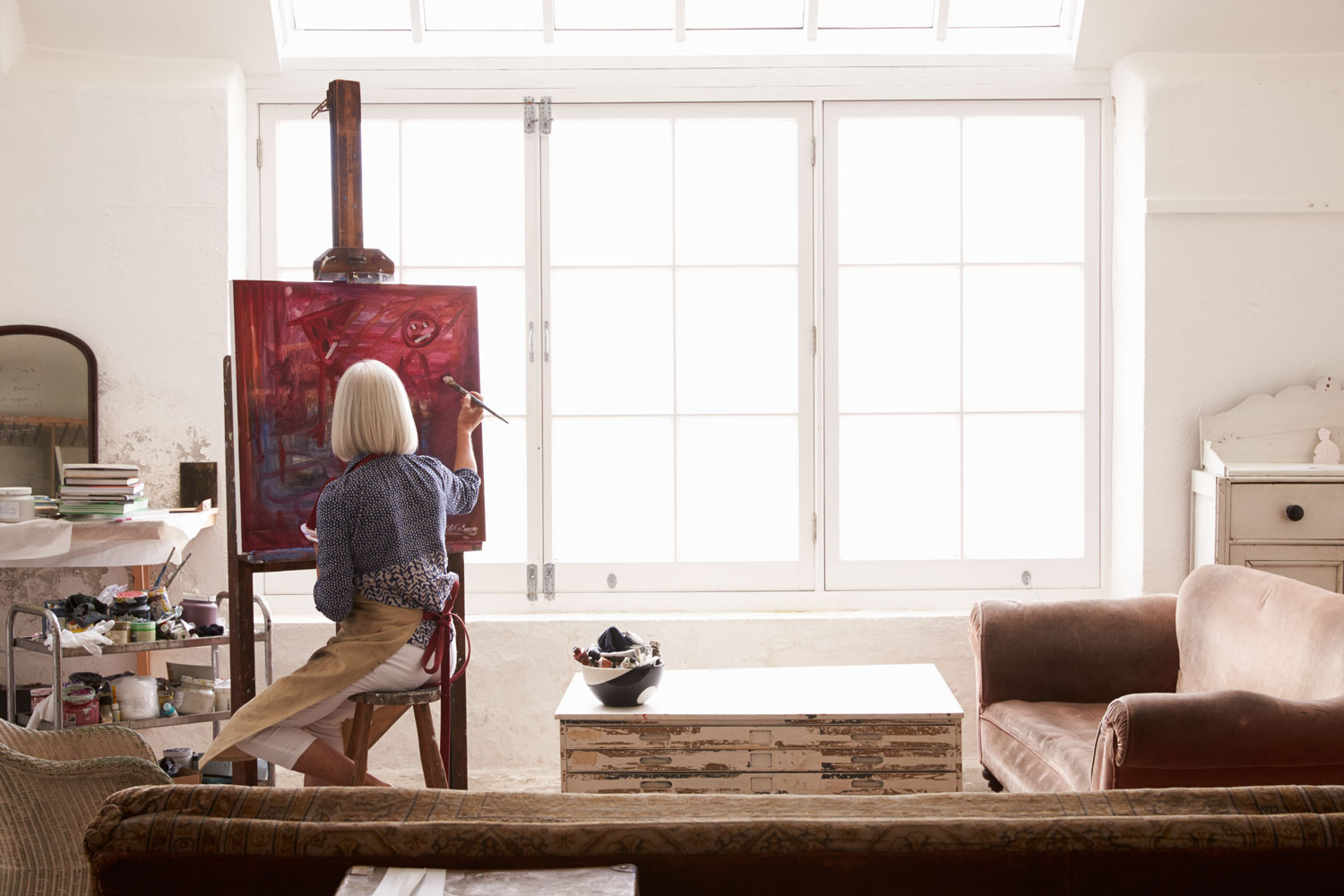
For centuries artists have been working on an easel. But why is that? And should you be working on an easel too?
The short answer is: yes, you should! 🙂 It really is important to work on an easel and in my online art classes I always recommend to use an easel. But why is that? Let me give you three reasons why you should work on an easel.
Easels have been used by artists for centuries. It is believed that easels were already used by the ancient Egyptians, and in the 1st century Roman scholar Pliny the Elder mentioned a “large panel” that was placed upon an easel.
Easels come in various types, and in a future blogpost I’ll discuss the differences between them. But what they all have in common, is that they are a structure onto which you can place your canvas or paper.
Now, when you first start working on an easel, it may feel a bit strange. From a young age we’ve learned to draw or paint with our paper flat on a table, so it takes a bit of time and practice to get used to working with your paper upright. It may be awkward in the beginning. You may feel a bit insecure and experience a lack of support for your hand, because you don’t rest it upon a table. But it is worth the effort. Why? Let me give you three reasons.
1. To see your work at the right viewing angle
Most artworks are meant to be viewed in an upright position, hanging on a wall. That’s why it’s important to create our art with the paper or canvas in an upright position as well, so that the viewing angle isn’t distorted.
If we work with our paper flat on a table, the viewing angle changes. This also changes the perspective. We all know that things which are further away, look smaller than things that are close by. This principle also applies to our paper when it’s lying flat on a table. The objects that we draw at the top part of the paper – which is further away from us – will look just slightly smaller than the objects that we draw at the bottom part of the paper. Unconsciously we will compensate this by drawing the objects at the top of the paper just a bit bigger.
As long as we are drawing and keeping the paper flat, it may look perfectly fine. But when we’re finished and we hold the paper in an upright position, the drawing may seem wonky and top-heavy.
When we draw with our paper upright on an easel, our viewing angle is less distorted because we can see most of the artwork just looking straight ahead. This makes it a lot easier to keep the proportions and measurements right.

Now, this distortion effect is subtle and also depends on the size of your paper. The bigger the paper, the bigger the difference in perspective, and therefore the more likely that your measurements will be off. But the principle always applies.
I remember really well when I discovered this for myself in practice. I had just started out drawing portraits, and I was working with my paper flat on the table. I never thought of using an easel – I kind of felt that easels were for ‘real artists’, not when you are just drawing for fun. So I had been working on my portrait for some time, and I was really happy with how it was going. And then when it was ready, I held my paper upright to take a look at the final portrait… And it looked totally wonky. The top part of the head looked strange, too big, while the lower part of the head seemed to be too small. I hadn’t noticed that at all when my paper was flat on the table. But then I realized my viewing angle had been distorted. So that was the last time I have been making portraits with my paper flat on the table. After that I’ve always been working on an easel.
This is especially important for artworks where measurements and proportions come into play, like portraits. When we want to draw and paint faces, it’s key to have the measurements and proportions right. Otherwise the face will look wonky or unbalanced. That’s why in my in-depth portrait class Drawing in the Soul we spend a lot of time working on the proportions for various face directions (front face, profile face, and three-quarter face). And therefore, when creating portraits, it’s really better to work on an easel. So that you have your work in the right viewing angle and see it in the right perspective.
Now, there are situations in which you can’t work with your paper in an upright position. For example when you’re working with very fluid mediums, like watercolor paint. In those cases you’ll just have to put your paper in an angle as straight as possible, maybe even just slightly upright. Every now and then you can stand up and look at your work from the top down, or hold your paper upright, to check the proportions. But if possible, I really recommend that you work on an easel.
2. To have more freedom of movement
Another reason why it is so important to work on an easel, is that it gives you more freedom of movement. When you draw with your paper flat, you rest your hand or wrist onto the table. That way your movements are more restricted than when you work at an easel, where you can move your whole hand and even your arm to make your marks and strokes. And that is especially important if you want to draw in an expressive or loose style.
When you work standing at an easel, it’s also easier to move around and to take a step back every now and then. It’s good to view your work from a further distance, because it helps to get a good overview and to see your work with ‘fresh eyes’.
Now, if you’re not able to stand for long times on your feet, you can also sit down in front of your easel. Make sure that your easel can be lowered, so that you have your work at the right hight in front of you and you don’t have to tilt your head.
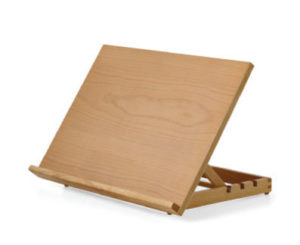 Another option is to use a table easel. A table easel is an easel that you can place on your table and it will hold your paper upright just like a regular easel. Even though you don’t have the advantage of being able to move around, you still have your paper at the right viewing angle and you can move your hand and arm better than when you have your paper flat on the table. Table easels are also usually not very expensive, so if a big easel is too much for your budget then you can also choose to work with a table easel.
Another option is to use a table easel. A table easel is an easel that you can place on your table and it will hold your paper upright just like a regular easel. Even though you don’t have the advantage of being able to move around, you still have your paper at the right viewing angle and you can move your hand and arm better than when you have your paper flat on the table. Table easels are also usually not very expensive, so if a big easel is too much for your budget then you can also choose to work with a table easel.
3. To keep a good posture
Lastly it’s good to work on an easel because it gives you a better posture. If you work with your paper flat on a table, chances are that you are leaning over your drawing. After a while that posture can cause a lot of tension in your neck and shoulder muscles, which in turn can lead to headaches and pain the neck, shoulders and even your back. It’s much better to stand upright at an easel, so you can keep your head and neck straight up while you’re working.
So these are 3 reasons why it’s important to work on an easel. And how about you? Do you work on an easel? Why, or why not? I’d love to hear your thoughts. Let me know in a comment below!
Foundational portrait course
If you would like to learn all about creating portraits, then my foundational portrait course Drawing in the Soul is for you.
In this in-depth online class we take a deep dive in fundamental art concepts like tonal value, line and color. You'll learn how to draw the facial proportions in various directions, and work with a host of different mediums and supplies: from acrylic paint to charcoal, pastel, collage, and more.
This class is suited for all levels: from complete beginners to more experienced artists. We'll start from the very basics and build up to more advanced levels.

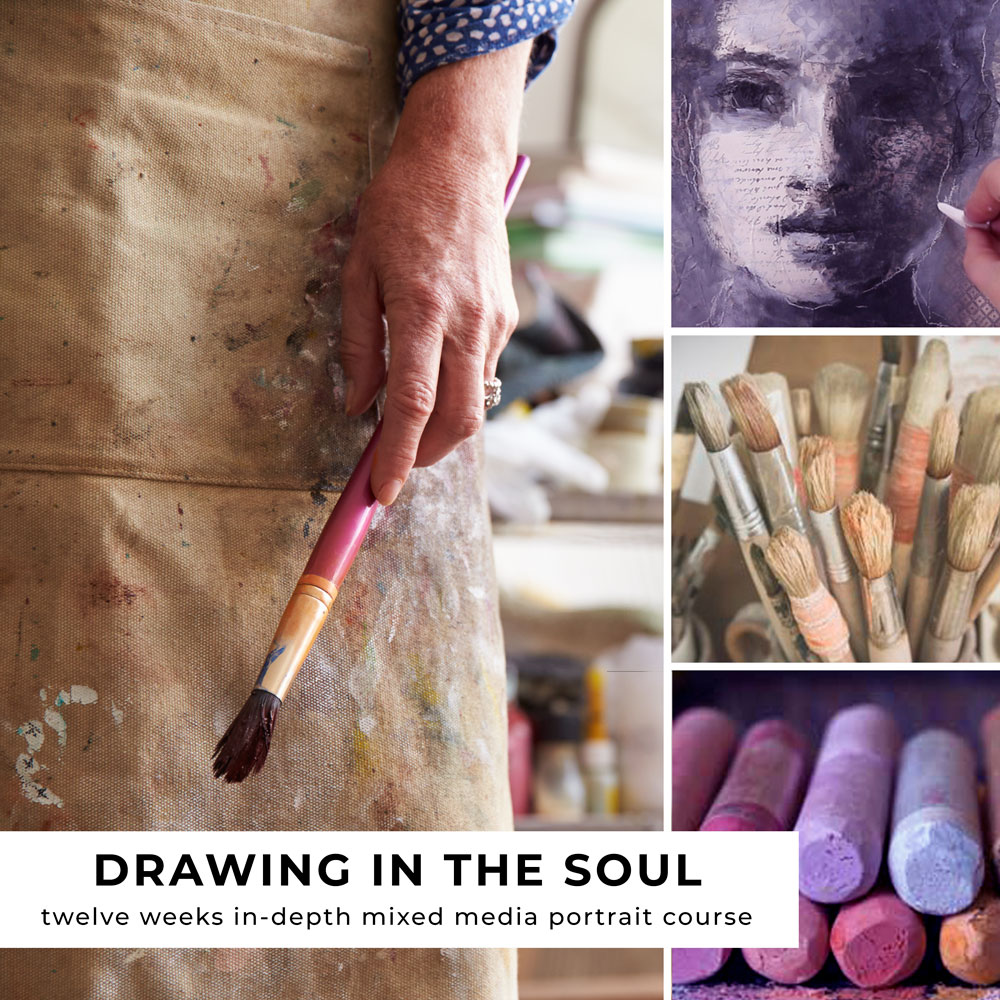

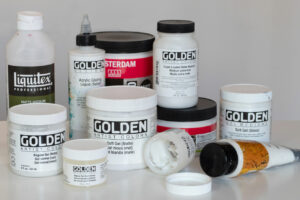

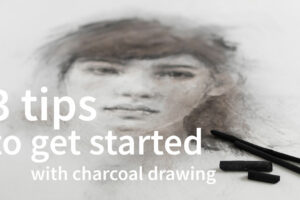
Absolutely! One extra tip I’d suggest is trying out different easel heights and angles to find your perfect setup.
Yes, great tip!
Hi!
You are very very informative? Do you have a newsletter? If so, please sign me up. Thank you for your insight.
Blessings and cheers
Layton
Hi Layton, glad to hear that! Yes, you can sign up for my newsletter here! 😊
I learned about the concept of wabi-sabi over 20 years ago and have been enamoured by the philosophy of it ever since… to see and revere the sacred transition of time on all things and every thing. Simply beautiful. So happy I fell upon this course. Thank you.
So glad to hear that Rose-Marie! Yes, it’s such a deep and beautiful concept and I love how you describe it. Thanks for stopping by! 🙂
Very helpful. thorough detailed interesting. Thank you so much
Thanks Linda, happy to hear that! 🙂
I have only done a couple of drawings with charcoal and pastels. I connected with your website looking for information on controlling the charcoal dust so the picture isn’t smudged. I ended up reading all your posts! What a great source of helpful information. I will be shopping for a tabletop easel today. I am 71 with fairly serious arthritis so I can’t stand for any length of time. I do a lot of different crafts but will be trying more charcoal drawings. I’m doing one for my sister of her dog that just passed away. Wish I knew how to include my two pictures to see what you think, and if I should continue doing these. Thank you for the information.
I’m so glad you found the information helpful Cindy! 😀 Yes, a table easel is very helpful when standing for a longer time is not possible. I’ve had to do that too and it works great. Yay for working with charcoal, it’s such a beautiful medium! If you’d like to share your work you can join my Facebook group Juna Biagioni’s Art Atlier. I’d love to see your drawings!
I am learning to work with an easel. The main issue I have is this: when I do find details I want to be close to the canvas. But because the canvas is always ‘leaning away’, even at its most upright position, and because I easel is an H-frame, I never know how to comfortably move close enough. I cannot stand for too long due to RA, I have a sit/stand chair with an adjustable seat, but I still find that I burden my right (dominant) side more that is good for me and my back. I wonder how you solve that issue.
We all have a dominant side and in the picture in the top of this page you can see how the lady is really not sitting with good posture. Her legs are sideways from her body and her shoulders are turned the other way.
I wonder if there are other type of easels, with a painting stand that can move towards the painting, in the same way a drawer would. That would leave room for the legs, straight under the easel frame and you would have your painting in your lap, so to speak.
I saw a frame on TV the other day, with free movements almost like a lamp you see at the doctor’s or dentist’s office. They can swivel it in any direction. Which is useful when you need to turn the canvas around to get to a corner without touching the wet surface. Is there anything like that on the market?
That’s an important issue that you bring up here Nicky! I do agree that regular easels are not the best for that. I don’t know if there are any specialized easels for this situation and I’m not an expert in ergonomics. But perhaps you can build something yourself, for instance based on a monitor stand that you somehow attach your canvas or board to? If you find a solution, please let us know because others may be struggling with the same problem.
Indeed i have learnt a lot of things from this page. So glad I found this masterpiece online. Thanks for sharing.
Thank you so much!
Thank you for the insight. I have two easels but haven’t “eased in” to drawing on them or painting on them. I draw and then put on the easel to adjust proportions. I have RA so cannot Stand Will try it next painting.
Yes, it can take a bit of time to get used to this way of drawing and painting, but it will pay off eventually. If standing is a problem, you can definitely try a (sturdy) table easel. Thanks for stopping by! 🙂
A recent convert to your page, teachings and work, thanks to FB and the Drawing Group….. before even starting with pencil in hand (sorry fusain) your piece on easels and working upright is an epiphany. I look forward to September and starting your on-line courses. Thank you so much Juna.
So happy you are inspired by my work Nik! And glad you found the information in this blog post useful. It will be awesome to have you in one of my classes! 🙂
This blog post was a game changer for me, Juna! Thank you so much. I have a very wobbly easel, but it still made such a difference when I’ve recently used it. Now I’ll be on the prowl for a sturdier easel. Thanks again!
That’s great to hear Lorie! It really does make a big difference, doesn’t it? And yes, if you can, get a good sturdy easel, just to spare you the frustration, lol! That will make a big difference too! 🙂
thank Juna for your explanation about why you should “use” an easel! I already knew that, perspective, being able to distance myself, my posture is better, and I never want to miss the space that I have to work. I only use paper flat on the table if I want to write something. A bit impatient I am now waiting for the registration of the next “summer” course “Drawing in the soul” … Birgitta🌸
Haha, that’s great Birgitta! I’m so looking forward to starting Drawing in the Soul again and it’s great that you’ll be in it! Good that you already know about how to use the easel. So important, isn’t it!